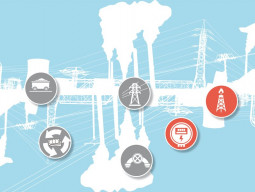
The film’s anti-hero is a thief — Loha Singh helps a lot of people steal electricity in Kanpur. He connects the illegal wire that is known in north India as katiya. Katiya is the sort of simple solution to life’s problems that South Asians feel very smart about. It’s an example of jugaad, the shortcut to problem solving that’s now integral to pop management theories.
As Loha Singh goes about connecting katiyas, the Kanpur Electricity Supply Corporation (KESCO) struggles with plans to make people pay for the electricity they use. KESCO officials go with police parties to raid houses, check meters, threaten police cases, collect fines and remove katiyas. But the heroic task is hampered, if not by the corruption of KESCO officials then by the public, which threatens them with violence. There was even a case that a policeman was burnt alive by the people. If the Kanpur administration was to seriously attempt to make people pay for electricity, there would be riots that would exceed the scale of the Hindu-Muslim violence Kanpur has seen rather often.
Loha Singh says in the film that KESCO only goes after the poor who steal relatively little electricity. A local politician named Irfan Solanki takes on the KESCO chief saying that if KESCO cannot guarantee uninterrupted power supply, it has no right to ask the people to pay for the meagre electricity they do get. KESCO says that it cannot provide 24/7 power supply if people won’t pay for it. As it is, the electricity rates are subsidised. As the film takes us through this cat-and-mouse game, elections arrive. Electricity is an issue in every politician’s speech in the film, including one by Prime Minister Manmohan Singh. Irfan Solanki wins the election and the KESCO chief who was trying to reform the situation is given a “punishment posting” elsewhere.
The people of Kanpur, rich and poor, are so used to free electricity they think it’s their birthright. There are people who do most of their cooking on a hotplate because the cooking gas cylinder isn’t free (yet). This is the story of not just Kanpur or Uttar Pradesh but many parts of India. In 2011, the Indian power sector’s transmission and distribution losses were 24 per cent. If these consumers could be made to pay up, the government would have more money to spend on power generation.
Loha Singh is right that they don’t go after the rich: big culprits in electricity theft are industries, which, of course, fill the pockets of politicians. One industrial unit, when told that its free electricity party was over, shut down. Its costs were no longer competitive.
If the party in power goes after everyone who steals electricity, the opposition will win sympathy and votes. Instead of leading the way to enlightenment, leaders lead the people to doom — which makes you wonder about democracy. Oops, I didn’t say that. Political parties have found a political opportunity in electricity shortfall. Which place will have more load-shedding than others depends on whom its voters voted for in the last election. The film-makers tell me that it was only in the 1990s, as political competition between parties increased, that a new electricity mafia rose and offered people the chance to get electricity without paying for it.
I think threatening people and forcing them to pay up is not going to work. The state should, instead, think of rewarding them for paying up: and the reward can only be uninterrupted supply. Electricity theft is only the second reason why India is power deficient. The main reason is the government’s own inability to efficiently use India’s coal reserves, not to speak of other means of electricity generation. If the state gets its act together, the people might follow. Or not!
Published in The Express Tribune, July 12th, 2013.
Like Opinion & Editorial on Facebook, follow @ETOpEd on Twitter to receive all updates on all our daily pieces.
COMMENTS (10)
Comments are moderated and generally will be posted if they are on-topic and not abusive.
For more information, please see our Comments FAQ











































@Lala Gee: Amazing, you found an article from U.P. that resonates with you and used that to extrapolate it with the whole of India. Also "the Shining India" slogan by the BJP seems to have struck a chord with more people in Pakistan than India. As a matter of fact, India was shining back then, but trust the Congress to once again remind us of the 80s. . Coming back to U.P. and its twin, Bihar, what the author says in this article and which most of us are aware of is that people have become used to receiving electricity for free primarily through the use of illegal connections. As a result, U.P. does not have money to pay for electricity. They can always buy electricity from the national grid but to do not have the money to do so. They are depending on the state's largess to stay afloat. The ruling parties of both states for so many years have lacked political will to take tough decisions. It must also be noted that a state nearer to both, Chattisgarh, is power surplus and sells its electricity to Karnataka which is two states away. Karnataka has also invested in power plants in Chattisgarh. . Overall the situation in U.P. and Bihar is very similar to that of Pakistan. And by the way, nobody is begging Pakistan to buy 1,000 megawatts of our electricity.
LOL. And I thought India had unmanageable quantities of surplus electricity, and that is why she was begging Pakistan to buy 1,000 megawatts of it, which otherwise was going down the drains. Ah! another myth of the "Shining India", a fairyland built on lies, demystified.
@ModiFied: I am as amazed as you are!
@Shivam Vij
"Water goes back into the ground."
Thank goodness you are writing for Pakistani audience.
Read. As first aayat says but you and Pakistanis don't do it any way.
There are detailed studies done on how free electricity is directly threatening water table in many parts of India.
@Shivam Viz, No, it doesn't. Only a small part of water seeps into the water table while a large part flows downhill. Draining out ground water through excessive use of submersible pumps has been a serious issue, especially in Andhra Pradesh where farmers are provided free electricity. At one time, the Government had to launch a campaign pleading farmers not to overuse submersible pumps or at least wait until monsoon season.
@Shivam Vij: Your question to @ModiFied could have been answered with a simple google search for the term ground water depletion India. Dozens of articles will show up. One of them is http://www.nasa.gov/topics/earth/features/india_water.html.
@ Shivam Vij: I wonder if you are the author of this article or someone else with false name. If you are the author, then I am really amazed at the level of your understanding. Please have a look at the following link which might help you to understand the subject.
http://jnuenvis.nic.in/subject/freshwater/groundwater.htm
Ask you elders about the water table levels in your village or town about 10-20 years back and compare that with present levels. water table has gone down by at least 100-150 feet in almost entire north-west India. Main cause of this has been the excessive water extraction for irrigation.
The fact that Indian filim makers are making documentaries that relate to every day issues and thereby are creating an awareness is an excellent sign. In issues such as the one you have described it is a complicated exercise to apportion blame but the maxim that the fish rots from the head downwards, mostly holds good. If the top got their act right the bottom would not be forced to do what they do......at least to a major extent.
Efforts of film maker deserve appreciation that he chose such an important topic. One major impact of free/ stolen electricity is the depleting ground water. Farmers operate tube wells even while its raining. Submersible pumps operate in houses continuously and water flows in streets. Ultimately the issue boils down to the quality of governance and people's moral. in sub-continent there is deficit on both accounts.